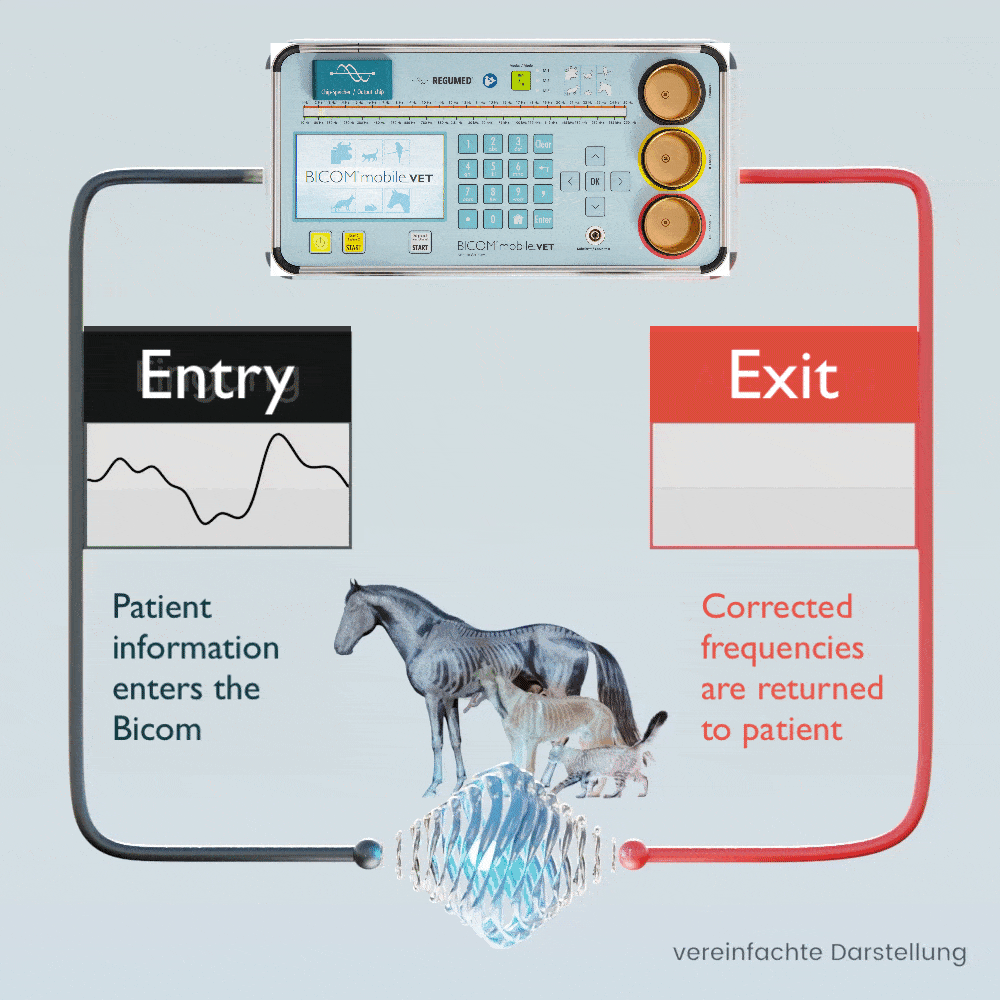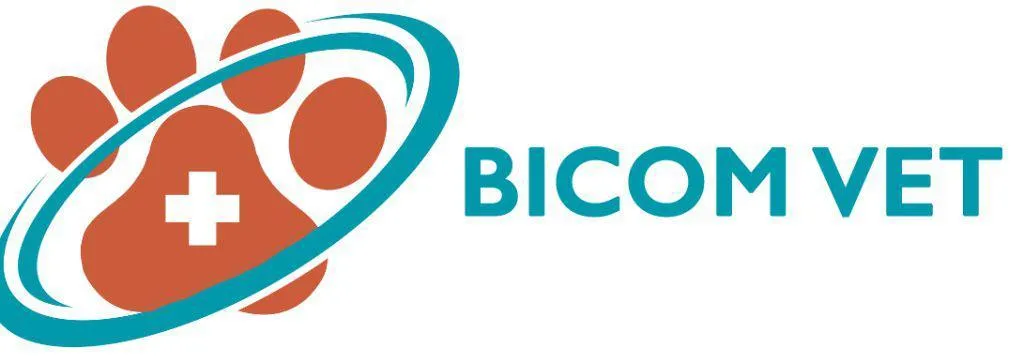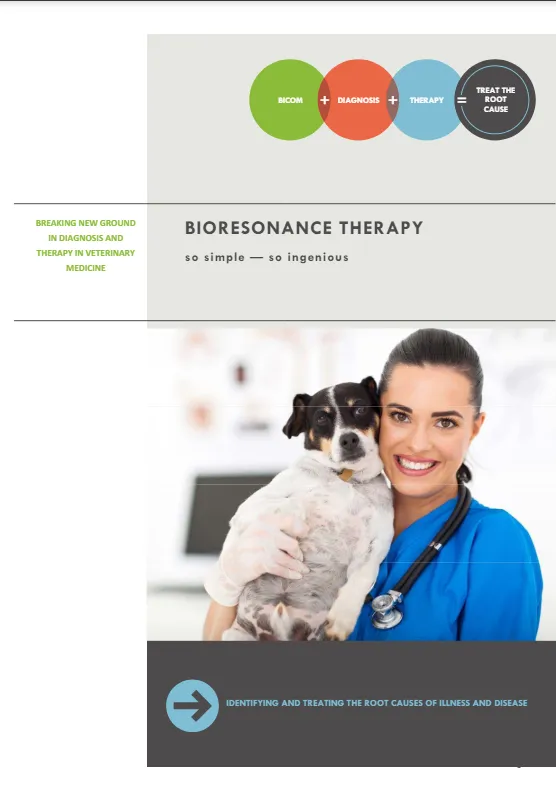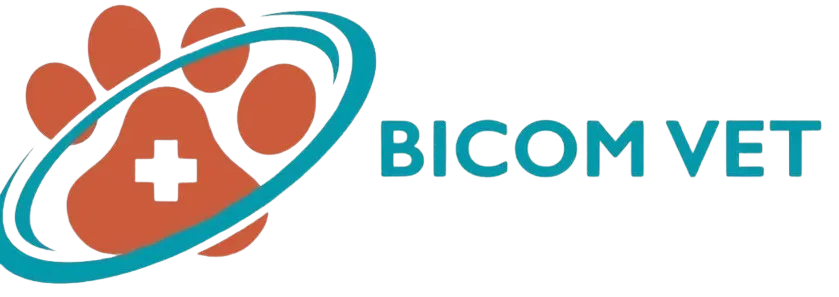Treatment with the help of the patient’s own information
in the BICOM® mobile VET bioresonance device
In contrast to other “frequency therapy devices”, BICOM® bioresonance is a method that is highly individual and perfectly tailored to the needs of the patient through the use of the patient’s own information and the possibility of testing specific wave patterns for resonance.
The patient’s own pathological and physiological information is recorded using special applicators and fed into the BICOM® mobile VET.
Depending on the therapy program, the specific wave pattern as a carrier of information is amplified, weakened or inverted and transmitted back to the patient in modulated form, which means that the transmission of information changes in clarity depending on the modulation or it disappears completely.
The treatment signals continuously adapt to the changing pathological situation of the patient. As the therapy progresses, the body’s ability to regulate is reactivated.
Find out more about this topic at our regular events. Together with veterinarians and animal naturopaths, we offer various face-to-face and online events .
The BICOM® bioresonance method is a cause-oriented, holistic treatment concept. It can narrow down the cause of the health problem in animals and find out even the hidden causes of the clinical picture.
Animals have a natural regulatory system that can also compensate for unusual influences. However, even good self-healing powers eventually reach their limits. Persistent exposure to allergens, environmental toxins, fungi, viruses, bacteria or stress and changed living conditions weaken the immune system and are often the cause of an illness. In particular, fungal infestation on the skin or chronic diseases in general are not always due to a breeding-related genetic defect, but are signs of a disturbed immune system.
The BICOM® bioresonance method is the key to successful diagnosis and therapy, especially for animals that cannot tell us exactly where it hurts or what the symptoms are. It is a gentle form of therapy that can be carried out without side effects and without additional stress for the animal.
The BICOM® mobile VET records the bioenergetic state of the animal, processes the information it contains and returns modified vibrations / therapy frequency patterns to the animal. Symptoms and stress can be diagnosed and targeted therapy can be initiated.
Through the use of endogenous and exogenous substances, the body’s own self-healing powers can be activated and imbalances that have existed for a long time can also be regulated.
REGUMED Medizintechnik are pioneers of the BICOM® bioresonance method. More than 30,000 therapists worldwide, well over 10,000 of them in Germany, successfully use their therapy concept.

Biophysical basics of the bioresonance method
Life is only possible when three conditions are met: matter, energy and information.
We also find these aspects in conventional medicine, both in diagnostics and in therapy. For example, every drug is also a carrier of information.
Information is neither energy nor matter, it is immaterial and comparable to the meaning of a message from a sending to a receiving system.
In addition to the electrical processes in the receptor proteins and biomembranes in general, electromagnetic interactions through light (biophotons) also play a role in cell communication and the transmission of information.
Specific electromagnetic wave patterns act as information carriers. These wave patterns can be modulated by the BICOM® device in order to eliminate disturbing or stressful information in an organism.
The goal is to restore the free flow of healing information (cell communication) and thus support the self-regulation of the organism and the self-healing powers.
Individual, patient-specific information or information from native substances, digitized substances or information stored on storage media can be used for therapy.
What your colleagues are saying…

Pets with Owners: The Unbreakable Bond Explained
The Unbreakable Bond Between Pets with Owners: A Relationship Built on Love
Pets with owners share a unique connection that goes beyond companionship. Studies show that owning a pet improves mental health, reduces stress, and even enhances physical well-being. Whether it's a dog wagging its tail in excitement, a cat curling up on your lap, or a bird chirping happily when you return home, these moments highlight the deep bond between pets and their owners.
Research indicates that pets recognize their owner’s emotions and respond with affection, comfort, and loyalty. The love between a pet and its owner is built on daily interactions, trust, and mutual understanding, making it one of the most fulfilling relationships a person can experience.
Why Do Pets and Owners Develop Such a Deep Connection?
Scientists and animal behaviorists have studied the relationship between pets and humans for decades. The results consistently show that pets provide not only companionship but also emotional stability, routine, and even physical health benefits.
One of the main reasons pets and owners form strong bonds is their ability to communicate without words. While pets cannot speak, they use body language, vocalizations, and behavior patterns to express their emotions. Similarly, owners develop a deep understanding of their pet’s needs and emotions over time, reinforcing their relationship.
The Science Behind the Pet-Owner Bond
Studies have revealed fascinating insights into the science behind the bond between pets with owners. Research published in the journal Science found that when dogs and their owners gaze into each other's eyes, both experience a rise in oxytocin, often called the "love hormone." This is the same chemical responsible for bonding between human parents and their children.
Additionally, brain scans of dogs show that they recognize their owner’s voice and respond with positive emotions. Cats, while more independent, also exhibit similar bonding behaviors, such as slow blinking, purring, and following their owners from room to room.
Emotional Benefits of Owning a Pet
The companionship of pets with owners is not just about having an animal at home—it significantly affects emotional well-being. Here’s how:
1. Pets Reduce Stress and Anxiety
Spending time with pets lowers cortisol levels, the stress hormone responsible for anxiety. Petting a dog or cat has been shown to reduce blood pressure and induce a calming effect.
2. Pets Increase Happiness
Interactions with pets release dopamine and serotonin, neurotransmitters associated with happiness and relaxation. This explains why many pet owners feel uplifted and comforted after spending time with their pets.
3. Pets Combat Loneliness
Many people, especially those living alone or experiencing emotional distress, find comfort in their pets. Pets provide companionship, making owners feel loved and needed.
4. Pets Encourage Social Interaction
Pet ownership often leads to increased social engagement. Dog owners, for example, frequently meet other pet lovers at parks, strengthening their social networks.
The Role of Routine in Building Up the Pet-Owner Relationship
Consistency is key when it comes to bonding with a pet. A structured routine helps pets feel secure and strengthens their connection with their owner.
1. Regular Feeding Times
Pets recognize feeding schedules and associate meal times with their owner’s care. Over time, this routine reinforces their trust.
2. Daily Walks and Playtime
Dogs, in particular, thrive on daily walks, and even cats enjoy scheduled play sessions. These moments strengthen the emotional bond between pets and their owners.
3. Grooming and Physical Touch
Regular brushing, petting, and even bathing help reinforce trust. Physical touch is an essential part of bonding, helping pets feel safe and loved.
How Pets Communicate with Their Owners
Even though pets cannot speak, they communicate in various ways. Understanding these signals helps strengthen the bond between pets with owners.
1. Body Language
Dogs wag their tails when happy or excited.
Cats slow-blink to show affection.
Birds fluff their feathers when comfortable.
2. Vocalizations
Dogs bark, whimper, or growl to express emotions.
Cats meow differently based on their needs.
Birds chirp or mimic words to communicate.
3. Behavioral Cues
Bringing toys signals a desire to play.
Following owners around shows attachment.
Licking or nudging is a sign of affection.
The Psychological Benefits of Pet Ownership for Humans
The impact of pets with owners extends beyond just companionship. Studies suggest that pet owners experience improved mental health, increased daily motivation, and lower levels of depression.
1. Pets Create a Sense of Purpose
Caring for a pet instills a sense of responsibility and routine. Feeding, exercising, and providing affection contribute to a structured lifestyle, which benefits mental well-being.
2. Pets Help Manage Anxiety and PTSD
Many therapy animals are trained to assist individuals with anxiety, PTSD, and other mental health conditions. Their calming presence reduces panic attacks and provides emotional stability.
3. Pets Promote Physical Activity
Dogs require daily exercise, encouraging owners to stay active. Regular physical activity is linked to lower risks of obesity, heart disease, and high blood pressure.
How Different Pets Form Attachments to Their Owners
While dogs and cats are the most common household pets, many other animals also develop strong connections with their owners.
1. Dogs: The Most Loyal Companions
Dogs are known for their loyalty and deep emotional connection with their owners. They crave interaction, training, and companionship, making them one of the most affectionate pets.
2. Cats: Independent Yet Affectionate
Cats may seem independent, but they form strong bonds through purring, slow blinking, and seeking physical closeness.
3. Birds: Intelligent and Social
Parrots and other birds recognize their owner’s voice and respond to interactions with vocalizations and playful behavior.
4. Small Mammals: Gentle Companions
Rabbits, guinea pigs, and hamsters develop trust through gentle handling and consistent care.
How to Build Up Your Bond with Your Pet
If you want to enhance your connection with your pet, try these strategies:
Spend Quality Time: Engage in daily play, training, or relaxing together.
Use Positive Reinforcement: Reward good behavior with treats and affection.
Understand Their Needs: Recognize stress signals and ensure a comfortable environment.
Respect Their Boundaries: Give pets space when needed to build trust.
The Lifelong Commitment of Pet Ownership
Bringing a pet into your life is a long-term commitment that requires responsibility, patience, and care. Pets depend on their owners for food, shelter, healthcare, and emotional support. Understanding their needs and providing a loving environment ensures a happy and fulfilling relationship for both the pet and the owner.
Responsible pet ownership includes regular veterinary check-ups, proper nutrition, daily exercise, and mental stimulation. Whether adopting a puppy, kitten, or an older rescue pet, it's essential to recognize the lifelong bond and commitment that comes with being a pet parent.
How Pets Positively Impact Family Life
Pets bring families closer by creating shared experiences and responsibilities. Whether it's taking the family dog for a walk, feeding the cat, or teaching children how to care for animals, pets encourage teamwork and bonding.
Studies show that children who grow up with pets develop empathy, responsibility, and better social skills. Pets also provide a source of comfort during stressful times, making them invaluable members of the household.
Conclusion
The connection between pets with owners is one of trust, love, and mutual understanding. Scientific studies confirm the numerous emotional, psychological, and physical benefits of having a pet. Whether it's a dog eagerly waiting at the door, a cat curling up beside you, or a bird singing in the morning, the bond between pets and their owners is truly special.
Owning a pet brings unconditional love, daily companionship, and a lifetime of cherished memories. Strengthening this bond through care, communication, and routine ensures that the relationship remains fulfilling for both the pet and the owner.
Pets with owners share a relationship that is loyal, loving, and unbreakable.
FAQs
1. How do pets benefit their owners emotionally?
Pets provide companionship, reduce stress, and increase happiness by offering unconditional love and emotional support.
2. Can pets recognize their owners?
Yes, pets recognize their owners through voice, scent, and visual cues, forming a strong bond over time.
3. Why do pets follow their owners around?
Pets follow their owners for security, companionship, and to seek attention or food.
4. Do pets understand human emotions?
Yes, pets can sense emotions through body language, tone of voice, and facial expressions.
5. What are the best ways to bond with a pet?
Spending quality time, engaging in play, training, and providing consistent care strengthens the bond.
6. How does pet ownership improve mental health?
Pets help reduce anxiety, combat loneliness, and provide a sense of purpose and routine.
7. Why do dogs and cats show affection differently?
Dogs express love through wagging tails and licking, while cats show it by purring, slow blinking, and cuddling.
8. Can pets miss their owners?
Yes, pets can experience separation anxiety and show signs of missing their owners when apart.
9. How do pets communicate with their owners?
Pets use body language, vocalizations, and behavioral cues to express emotions and needs.
10. What is the best way to make a pet feel loved?
Providing consistent care, affection, training, and playtime ensures a pet feels loved and secure.
Treatment Priorities
For gentle and optimal treatment of the causes of diseases in animals
The BICOM® bioresonance method is predestined for use with large and farm animals such as horses , but also with dogs , cats and small animals. The treatment focus of the BICOM® mobile VET is wide-ranging. It is now used for many indications.
It recognises health deficits at an early stage and is used, among other things, for the following symptoms:
sweet itch
Feed intolerances
allergies and related diseases
COB/COPD
leishmaniasis
Lyme disease
anaplasmosis
lameness in horses
hoof ulcer
Poisoning by poisoned baits, plants etc.
mauke
Feline infectious peritonitis (FIP)
Cat flu/cat disease
eye/conjunctivitis
and much more
Get advice now!
Our experts are happy to be there for you personally
Our BICOM® bioresonance experts are available to answer any questions you may have
and will be happy to advise you personally and individually.




Request more information
Quick Links





Facebook
Instagram
Mail